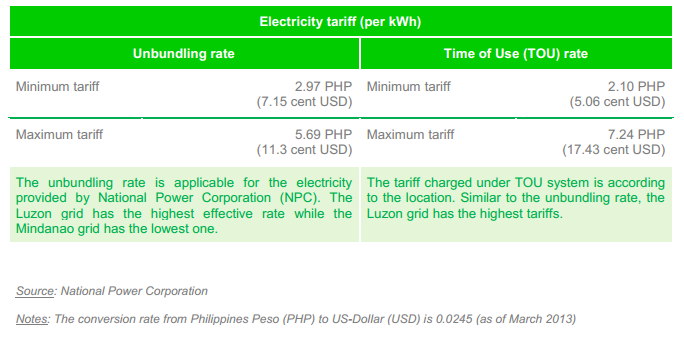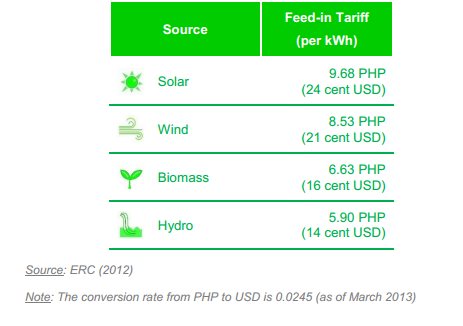Knowledge fuels change
For over a decade, Energypedia has shared free, reliable energy expertise with the world.
We’re now facing a serious funding gap.
Help keep this platform alive — your donation, big or small, truly matters!
Thank you for your support
Difference between revisions of "Philippines Energy Situation"
***** (***** | *****) m |
***** (***** | *****) |
||
| Line 1: | Line 1: | ||
| − | {{CES Country | + | {{CES Country|CES Country Name=Philippines |
| − | |CES Country Name=Philippines | ||
|CES Country Capital=Manila | |CES Country Capital=Manila | ||
|CES Country Region=East Asia & Pacific | |CES Country Region=East Asia & Pacific | ||
| Line 6: | Line 5: | ||
}} | }} | ||
| + | = Energy Situation = | ||
| − | + | The Philippines is an emerging economy and its economy has greatly shifted from agriculture to industry.In terms of energy use, conventional fossil fuels (oil and gas) are the main source for its primary energy demands. According to the 2011 primary energy consumption of the Philippines, 31% of the consumption was met by oil, 20% by coal, 22% by geothermal, 12% by biomass, 6% by hydro and 1% by other renewable energy like wind, solar and biofuel. <ref name="ASEAN">http://aseanrenewables.info/wp-content/uploads/2013/07/PH-Philippines_Rev05.pdf </ref> | |
| − | The Philippines is an emerging economy and its economy has greatly shifted from agriculture to industry.In terms of energy use, conventional fossil fuels (oil and gas) are the main source for its primary energy demands. According to the 2011 primary energy consumption of the Philippines, 31% of the consumption was met by oil, 20% by coal, 22% by geothermal, 12% by biomass, 6% by hydro and 1% by other renewable energy like wind, solar and biofuel. <ref name="ASEAN">http://aseanrenewables.info/wp-content/uploads/2013/07/PH-Philippines_Rev05.pdf </ref> | ||
The Philippines is located in the Pacific Ring of Fire and thus has a high geothermal potential. In terms of electricity generation, 41.4% of the electricity demand is met by geothermal energy, 28% by coal, 11.4% by hydro, 15% by natural gas and 0.1% by wind, solar and biofuel. In terms of installed capacity for power generation Hydro is 63.2%, 35.1% is geothermal , 1.1% is biomass and 0.6% by wind and 0.1% solar. <ref name="ASEAN">http://aseanrenewables.info/wp-content/uploads/2013/07/PH-Philippines_Rev05.pdf </ref> | The Philippines is located in the Pacific Ring of Fire and thus has a high geothermal potential. In terms of electricity generation, 41.4% of the electricity demand is met by geothermal energy, 28% by coal, 11.4% by hydro, 15% by natural gas and 0.1% by wind, solar and biofuel. In terms of installed capacity for power generation Hydro is 63.2%, 35.1% is geothermal , 1.1% is biomass and 0.6% by wind and 0.1% solar. <ref name="ASEAN">http://aseanrenewables.info/wp-content/uploads/2013/07/PH-Philippines_Rev05.pdf </ref> | ||
= Electricity Situation = | = Electricity Situation = | ||
| − | The table below provides an overview of the electricity tariffs in Philippiness<ref name="ASEAN">http://aseanrenewables.info/wp-content/uploads/2013/07/PH-Philippines_Rev05.pdf </ref>: | + | |
| − | [[File:Electricity Tariff Philippines.PNG|border|Electricity Tariff in Philippines]] | + | The table below provides an overview of the electricity tariffs in Philippiness<ref name="ASEAN">http://aseanrenewables.info/wp-content/uploads/2013/07/PH-Philippines_Rev05.pdf </ref>: [[File:Electricity Tariff Philippines.PNG|border|684px|Electricity Tariff in Philippines|alt=Electricity Tariff in Philippines]] |
= Policy = | = Policy = | ||
| − | The Government of Philippines has introduced various policies to foster renewable energy . Some of the policies are income tax holiday up to 7 years, duty-free import of equipment for renewable energy technologies and so on. In 2012, the government launched the new feed-in tariff (FIT) and is summarized in the table below<ref name="ASEAN">http://aseanrenewables.info/wp-content/uploads/2013/07/PH-Philippines_Rev05.pdf </ref>:<br/> | + | |
| − | [[File:Energy Policy in Philippines.PNG|border|Feed in Tariff in the Philippines]] | + | The Government of Philippines has introduced various policies to foster renewable energy . Some of the policies are income tax holiday up to 7 years, duty-free import of equipment for renewable energy technologies and so on. In 2012, the government launched the new feed-in tariff (FIT) and is summarized in the table below<ref name="ASEAN">http://aseanrenewables.info/wp-content/uploads/2013/07/PH-Philippines_Rev05.pdf </ref>:<br/>[[File:Energy Policy in Philippines.PNG|border|463px|Feed in Tariff in the Philippines|alt=Feed in Tariff in the Philippines]] |
| + | |||
| + | = Further Information = | ||
| + | |||
| + | *[http://www.irena.org/DocumentDownloads/Publications/IRENA_RRA_Philippines_2017.pdf IRENA Renewables Readiness Assessment (RRA) (2017):]Like many countries in South East Asia, the Philippines faces twin challenges of population growth and rising energy demand. Dependent on imports for nearly half its primary energy supply, the country is highly exposed to oil price volatility. Frequent tropical storms, meanwhile, adversely impact its energy infrastructure. In response, the Philippines has resolved to bolster energy security, pursue low-carbon economic development and contribute global efforts against climate change. Renewable energy technologies have become increasingly prominent in national planning and policy-making. An ambitious target adopted in 2011 calls for 15.3 gigawatts of renewable power capacity by 2030. This RRA, undertaken in co-operation with the Philippine government, identifies barriers and proposes key actions to strengthen the policy, regulatory and institutional framework in order to accelerate renewable energy deployment. | ||
| + | |||
= Reference = | = Reference = | ||
| + | |||
<references /> | <references /> | ||
| − | |||
| − | |||
| − | |||
Revision as of 11:42, 10 April 2017
Capital:
Manila
Region:
Coordinates:
13.0000° N, 122.0000° E
Total Area (km²): It includes a country's total area, including areas under inland bodies of water and some coastal waterways.
XML error: Mismatched tag at line 6.
Population: It is based on the de facto definition of population, which counts all residents regardless of legal status or citizenship--except for refugees not permanently settled in the country of asylum, who are generally considered part of the population of their country of origin.
XML error: Mismatched tag at line 6. ()
Rural Population (% of total population): It refers to people living in rural areas as defined by national statistical offices. It is calculated as the difference between total population and urban population.
XML error: Mismatched tag at line 6. ()
GDP (current US$): It is the sum of gross value added by all resident producers in the economy plus any product taxes and minus any subsidies not included in the value of the products. It is calculated without making deductions for depreciation of fabricated assets or for depletion and degradation of natural resources.
XML error: Mismatched tag at line 6.2 ()
GDP Per Capita (current US$): It is gross domestic product divided by midyear population
XML error: Mismatched tag at line 6. ()
Access to Electricity (% of population): It is the percentage of population with access to electricity.
XML error: Mismatched tag at line 6.no data
Energy Imports Net (% of energy use): It is estimated as energy use less production, both measured in oil equivalents. A negative value indicates that the country is a net exporter. Energy use refers to use of primary energy before transformation to other end-use fuels, which is equal to indigenous production plus imports and stock changes, minus exports and fuels supplied to ships and aircraft engaged in international transport.
XML error: Mismatched tag at line 6.no data
Fossil Fuel Energy Consumption (% of total): It comprises coal, oil, petroleum, and natural gas products.
XML error: Mismatched tag at line 6.no data
Energy Situation
The Philippines is an emerging economy and its economy has greatly shifted from agriculture to industry.In terms of energy use, conventional fossil fuels (oil and gas) are the main source for its primary energy demands. According to the 2011 primary energy consumption of the Philippines, 31% of the consumption was met by oil, 20% by coal, 22% by geothermal, 12% by biomass, 6% by hydro and 1% by other renewable energy like wind, solar and biofuel. [1]
The Philippines is located in the Pacific Ring of Fire and thus has a high geothermal potential. In terms of electricity generation, 41.4% of the electricity demand is met by geothermal energy, 28% by coal, 11.4% by hydro, 15% by natural gas and 0.1% by wind, solar and biofuel. In terms of installed capacity for power generation Hydro is 63.2%, 35.1% is geothermal , 1.1% is biomass and 0.6% by wind and 0.1% solar. [1]
Electricity Situation
The table below provides an overview of the electricity tariffs in Philippiness[1]: 
Policy
The Government of Philippines has introduced various policies to foster renewable energy . Some of the policies are income tax holiday up to 7 years, duty-free import of equipment for renewable energy technologies and so on. In 2012, the government launched the new feed-in tariff (FIT) and is summarized in the table below[1]:
Further Information
- IRENA Renewables Readiness Assessment (RRA) (2017):Like many countries in South East Asia, the Philippines faces twin challenges of population growth and rising energy demand. Dependent on imports for nearly half its primary energy supply, the country is highly exposed to oil price volatility. Frequent tropical storms, meanwhile, adversely impact its energy infrastructure. In response, the Philippines has resolved to bolster energy security, pursue low-carbon economic development and contribute global efforts against climate change. Renewable energy technologies have become increasingly prominent in national planning and policy-making. An ambitious target adopted in 2011 calls for 15.3 gigawatts of renewable power capacity by 2030. This RRA, undertaken in co-operation with the Philippine government, identifies barriers and proposes key actions to strengthen the policy, regulatory and institutional framework in order to accelerate renewable energy deployment.





















